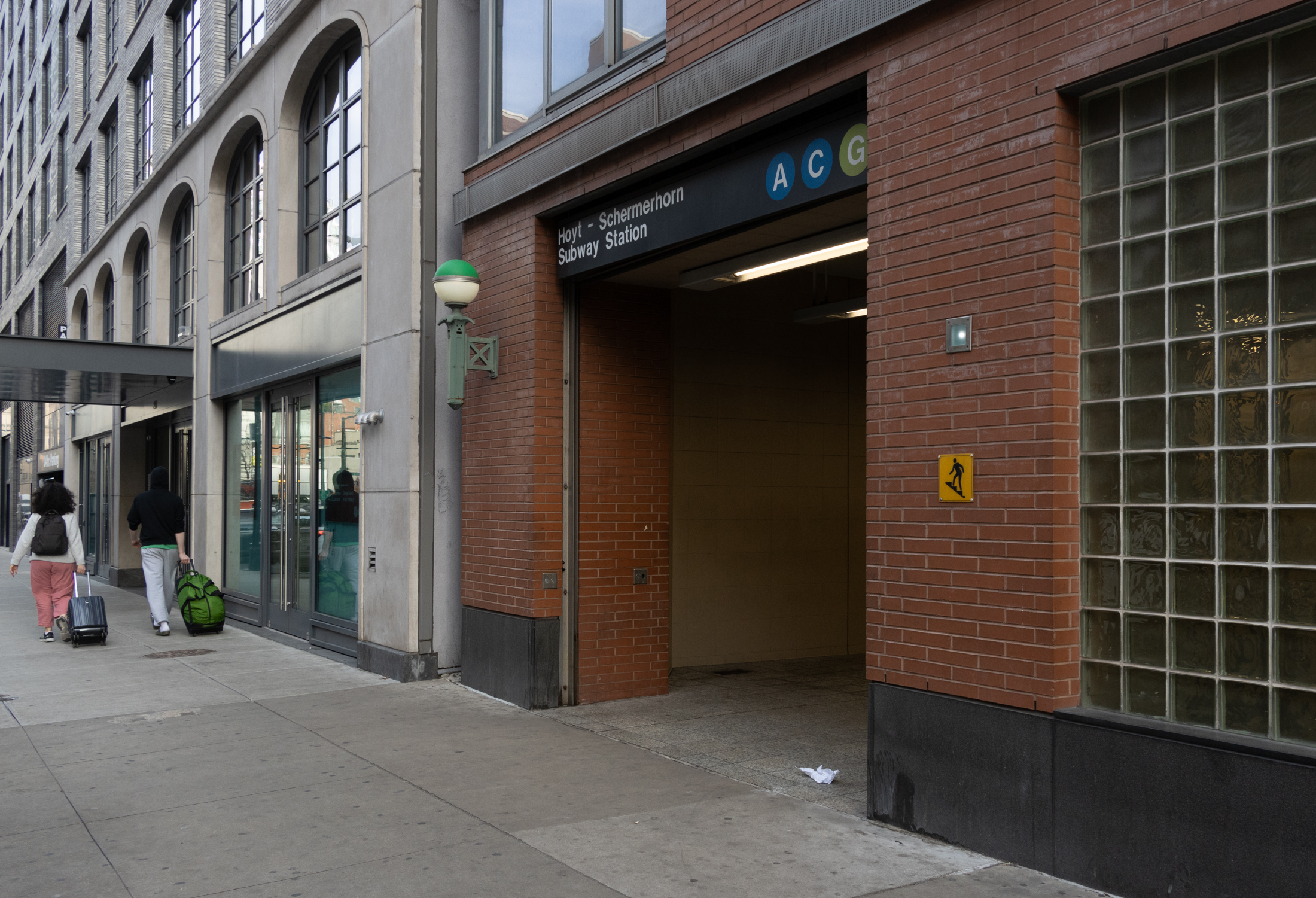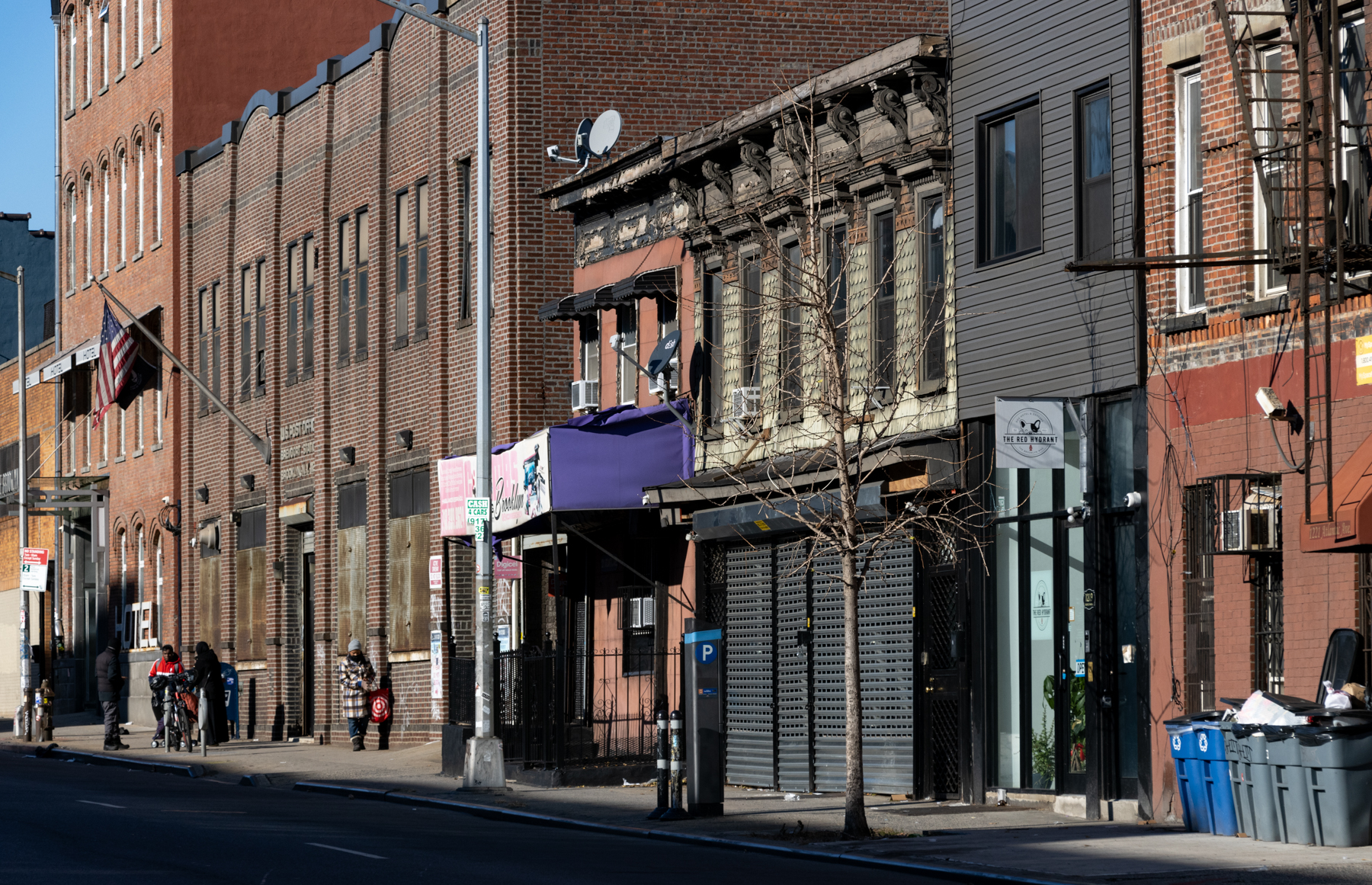NYPD: Fare Evasion Played a Role in Downtown Brooklyn Subway Shooting
Officials said policing fare evasion can prevent bigger crimes, while critics counter it can result in inequitable policing of people and communities of color.

A man remains in critical condition after a shooting aboard an A train at the Hoyt-Schermerhorn Street station on Thursday, March 14. Photo by Susan De Vries
By Isabel Song Beer, Brooklyn Paper
The New York Police Department is claiming the act of fare evasion played a significant role in Thursday afternoon’s subway shooting.
NYPD Chief of Department Jeffrey Maddrey, Deputy Commissioner of Operations Kaz Daughtry and Deputy Commissioner of Public Information Tarik Sheppard provided little update in regards to the crime while addressing reporters outside of the Hoyt-Schermerhorn subway station in Downtown Brooklyn on Friday.
During the press conference, the three NYPD top brass members indicated that the 36-year-old individual who was shot with his own firearm had skirted paying subway fare before entering the system.
“It is important that the NYPD enforces quality of life,” Maddrey said. “It’s important that we enforce that service and people who are not paying the fare, oftentimes we see people enter the subway station looking to cause harm and they never pay the fare. So this is why we stress to our officers it’s important to address theft of service.”
According to the department, the gunman was able to access the subway system by ducking in through open emergency exit doors, skipping out on paying the subway’s $2.90 fare.
Police say the shooter — a 32-year-old man who authorities have not yet identified — boarded a northbound A train at Nostrand Avenue at approximately 4:45 p.m. on March 14 before being confronted by the 36-year-old victim, who was shown on video recorded by fellow passengers to be threatening the 32-year-old verbally and physically. Video footage shows the 36-year-old repeatedly shouting racist threats of violence, apparently under the impression that the 32-year-old was a migrant.
The 36-year-old then allegedly withdrew a firearm and threatened the 32-year-old before a scuffle ensued in which the 32-year-old managed to obtain the firearm, turning it against the 36-year-old and shooting him in the head as the train approached the Hoyt-Schermerhorn station in the confines of the 84th police precinct.
The 36-year-old was taken to NewYork Presbyterian Brooklyn Methodist, where he was still listed in critical condition as of Friday. The crime is under active investigation.

According to Daughtry, several police officers were stationed at Hoyt-Schermerhorn and heard four shots fired before leaping into action.
“As the officer first hit the platform, he heard a shot, they immediately took out their weapons and as people were running up the stairs, they were running towards danger,” said Daughtry. “So these officers should be commended for what they did because they didn’t know what they were getting into.”
At Friday’s press conference, NYPD officials seemed to bemoan the fact that the news media was sensationalizing the shooting, overshadowing the apparently otherwise uneventful day.
“We all heard about what happened yesterday, but nobody is talking about the millions and thousands of people that got to their destination safely,” said Daughtry. “So we let this one incident — and I know it’s gonna leave a traumatic experience on the people that were affected by this — but also there were people that got to their destination safely.”
Daughtry then doubled down on the claim that focusing NYPD presence on subway fare evasion would reduce violence on public transit.
“Like the chief said, we are seeing a small group of individuals that we catch during these fare evasion operations that are recidivists, that have warrants, that have guns, that have knives and they don’t pay the fare,” he said. “Like I have people who said before ‘small things as walking through an exit gate or hopping over the turnstile leads to big things.’”
This narrative echoes a larger push by the department to blame surges of violent crime on the escalation of minor offenses, likening fare evasion to something of a gateway crime to larger felonies.
However, some experts believe that criminalizing fare evasion leads to inequitable policing of people and communities of color.
“A big police presence around a very minor offense of not paying at the fare gate is just caustic to communities of color in the way that it’s been enforced,” Jonathan Smith, senior special counsel for the Washington Lawyers’ Committee for Civil Rights told the Washington Post last year.
According to Maddrey, 17 weapons so far this year have been confiscated by NYPD officers enforcing fare evasion searches. It is unclear how many fare evasion stops have been conducted so far this year, but a recent NYPD report indicates that subway crime is up 22 percent since the start of the 2024.
NYPD brass continually assured New Yorkers that Thursday’s shooting was an isolated incident and that the system is safe to use, encouraging individuals to use public transit this past weekend to attend the annual St. Patrick’s Day parade.
“When you think about our transit system, there’s nothing comparable to anywhere else in the country,” said Sheppard. “We move around 200 million riders each year and at the end, every victim matters, but we are talking about a very minuscule amount of violence that happens in our system. While it can be polarizing and it can put people in fear, we understand that but we are keeping a large system and a large amount of people safe.”
Editor’s note: A version of this story originally ran in Brooklyn Paper. Click here to see the original story.
Related Stories
- Teen Killed After Falling Onto Subway Tracks in Bushwick While Subway Surfing
- Sunset Park Holds ‘Day of Unity’ After Subway Shooting
- Tip Leads to Arrest of Suspected Brooklyn Subway Shooter After 30-Hour Manhunt
Email tips@brownstoner.com with further comments, questions or tips. Follow Brownstoner on Twitter and Instagram, and like us on Facebook.









What's Your Take? Leave a Comment